Abstract
Electrochemical microfluidic technology has been extensively studied in many fields due to its significant advantages. Despite the increasing number of publications on the subject, there are no studies based on bibliometric analysis in this area. In this study, we performed a bibliometric analysis of 457 publications related to electrochemical microfluidic technology during 2012–2021 through the Web of Science core database. Results show that the hot topics include the development of label-free immunosensors, biosensors, microfluidic device performance, and low cost of equipment, and the major contributors to these publications are from China, USA, Spain, India, and Germany. In addition, applications of electrochemical microfluidics in biomedicine, food safety, and environmental monitoring are summarized and analyzed. Finally, the future challenges as well as strategies for future research are discussed. This bibliometric review will be useful for researchers in gaining new insights into the electrochemical microfluidic technology.
1. Introduction
In recent years, microfluidic technology has attracted the attention of academia and industry with the shift of the macroscopic world to the microscopic realm in people’s exploration. Microfluidics refers to the science and technology involved in systems that use microchannels to process micro fluids. It is a cross discipline involving chemistry, fluid physics, microelectronics, new materials, and biomedical engineering. It is focused on creating microfluidic channel systems to perform numerous complex microfluidic manipulation functions, including the control, manipulation, and detection of fluids at microscopic sizes [1]. Microfluidic devices are often known as microfluidic chips, lab on a chip, or micro-total analytical system. There are many outstanding advantages of microfluidic systems such as small volume of sample analysis, easy automation, fast response, effective selection of separation, device portability, and simplicity of operation [2]. Microfluidics had a revolutionary impact in the fields of biosensing [3], catalysis [4], medicine [5], chemistry, and materials synthesis [6] due to its unique advantages. In addition, a wide variety of detection methods can be used in conjunction with microfluidics, ranging from electrochemical or biosensors integrated on a chip [7,8] to various external detectors, such as mass spectrometry [9], fluorescence microscopy [10], portable lightbox, and cellphone technology [11]. Combined with most of the currently popular rapid assays, it can provide more accurate results by concentrating sample pretreatment, reagent reaction, and separation detection operations on a single chip.
Electrochemistry has been recognized commonly as a useful analytical method developed over a century [12]. In electrochemical detection, it is characterized by high sensitivity and inherent miniaturization, in which the electrodes and the entire detection device can be infinitely miniaturized. The microfluidic technique can manipulate liquid volumes of less than μL [13] and it sometimes requires the integration of a micro detector in this device. The feature of scaling down electrochemical detectors without loss of performance is exactly what microfluidic devices need. In general, the approach combining electrochemical detection and microfluidics can be achieved by immobilizing sensitive electrodes with bioactive molecules on a microfluidic substrate. The sensitive electrode converts the biochemical signals generated between the substance and the immobilized biomolecule into electrical signals such as current, potential and impedance for qualitative or quantitative detection. The combination of microfluidic micrometer channels and electrochemical techniques is currently of interest because of its high throughput, sensitivity, specificity, and low detection limits [14,15,16].
For the past few years, the number of publications on electrochemical microfluidic technology has continued to grow, but few reports examined its development dynamics from the perspective of bibliometric analysis. The current bibliometric analysis not only focuses on annual publication volume, literature type, publication language, keyword frequency, journals, and subject categories, but also allows for systematic network construction and visualization based on the relationships among key indicators such as authors, research institutions, countries, journals, and keywords [17,18]. Through bibliometric analysis, it is possible to summarize the current status of research in a certain field and predict the future development trend of scientific research on this basis to provide a reference for researchers.
In this paper, we analyze the literature related to electrochemical microfluidic technology in the last decade and systematically analyze the current research results and research hotspots. The current problems and challenges are discussed, and the future development trends of electrochemical microfluidics are also prospected.
2. Methodology
The literature in this study was retrieved from the Web of Science core database on 20 August 2022, using the subject keywords TS = (“electrochemical” AND “microfluidic technology”) and the time frame was set by literature published years from 2012 to 2021. Further re-screening was performed in terms of language (English) and document type (articles and reviews). All the data were gathered in “txt” files that include complete records and cited references. A total of 457 related publications were collected.
CiteSpace and VOSviewer are two commonly used bibliometric software, both of which visualize research domain information through metric modeling and mapping of relevant literature [19,20,21]. Specifically, CiteSpace focuses on research frontier identification and hotspot evolution trend analysis, while VOSviewer focuses on the presentation of informatics mapping [22]. CiteSpace 5.8 R3 and VOSviewer 1.1.16 were used to analyze authors, countries, institutions, journals, co-citations and key words to study different research fields. The analysis was conducted to study the hotspots and trends in the field at different time periods. The related data were organized and calculated using Microsoft Excel 2019 software.
3. Results
3.1. Publication Language, Document Type and Growth Trend
The annual distribution analysis considering the literature quantitatively indicates the attention received by the field, as well as reflects the different developmental histories of research on the topic. The annual articles published from 2012 to 2021 were counted, and the increasing trend is shown in Figure 1a. The trend is divided into two stages. The first is the initial stage of electrochemical microfluidic technology from 2012 to 2015 and the average number of published articles per year is nearly 26. The second is the growth and development stage from 2015 to 2021 with a rapid increase in the number of published articles per year. In 2021, the number of published articles was 89, which is 3.2 times more than published in 2015. It is evident that the research in this field is expanding.
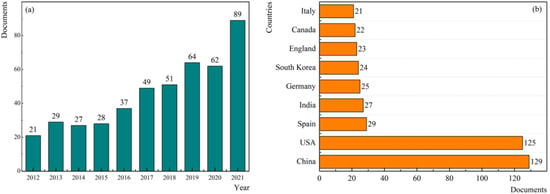
Figure 1.
(a) Quantity of documents published per year; (b) The publication number of top 9 countries during 2012–2021 in this field.
As microfluidic technology spread worldwide, many research institutions have increased their research efforts. This is mainly due to more and more companies at home and abroad being committed to the development of microfluidic technology. It has a large share of annual publications in China, one of the reasons is the Ministry of Science and Technology released the “13th Five Year” Special Plan for Biotechnology Innovation in 2017, which clearly brings microfluidic chips into the category of new generation biological detection technology. Meanwhile, it is expected that the number of relevant research papers will continue to grow in the future with the advancement of the new national science and technology strategy and become a new focus of attention.
3.2. Author and Co-Author’s Analysis and Network
It is possible to understand the representative scholars and core research strengths of the research field by analyzing the collaborative network characteristics of the authors. A total of 2127 authors were involved in this research area from 2012 to 2021. The network visualization of co-authorship authors is shown in Figure 2, where 225 authors who have published more than two cooperative articles were counted. Henry, C.S. published the most articles and Wang, J. received the highest number of citations in this field.

Figure 2.
The network visualization of co-authorship authors.
In terms of collaboration and coordination, the number of clusters is 56, and nine of them include more than six co-authors. Meanwhile, there are many isolated nodes and weak cooperation among authors, a situation that is not conducive to the development of electrochemical microfluidics in the long run. It should be emphasized that the statistical results are based on a maximum of 25 co-authors per article. One of the articles is called “Multisensor-integrated organs-on-chips platform for automated and continual in situ monitoring of organizational behaviors”, which has more than 25 co-authors.
3.3. Publication Distribution by Countries
In order to understand which countries are making the most significant contributions to the field of electrochemical microfluidics, the volume of publications from 53 countries were analyzed in this paper. The top nine countries with the highest number of publications is shown in Figure 1b. The top five countries in terms of number of publications are China (129), USA (125), Spain (29), India (27), and Germany (25). Among them, China and the USA were the two countries with the highest number of publication articles. China accounted for around 28% of the total articles located in the first place, followed by the USA with only four fewer publications than China. Other than that, the number of papers from other countries is less than 30. Figure 3 shows the country’s collaboration network map, where a larger circle node represents more published documents, the thicker line represents a stronger association between the two countries, and the color of the node represents the different clusters. It is indicated that China and the USA work most closely together, the distribution of publications in this field is very uneven, and the top effect is significant with most of the papers being authored by scholars from a few countries.
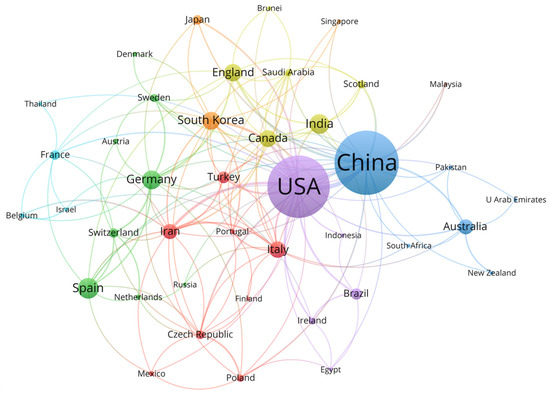
Figure 3.
The network map of countries’ collaboration.
3.4. Journals Contribution and Co-Citations Source Visualization
A total of 457 articles related to electrochemical microfluidics were published in 178 journals since 2012–2021. Table 1 shows the top five journals in terms of number of publications. “Biosensors & Bioelectronics” is the top ranked journal, and it has published 262 papers, accounting for 2.85% of the total. The journal “sensors” was the second ranked journal with 252 publications. Table 2 lists the top 15 journals with the highest number of co-citations between the 457 articles collected. Among them, “Analytical Chemistry” is ranked first with 3136 citations, followed by “Biosens bioelectron”.

Table 1.
Top 5 journals with most of publications.

Table 2.
Top 15 journals with most co-citations of publications.
Figure 4 and Figure 5 show the visualization and density of the co-citation source network between the 457 articles collected. The collaboration amid of journals is denoted by the connecting line among nodes. The co-citation is determined by the number and thickness of the lines, and the size of the nodes is connected to the total link strength. The larger nodes represent greater total connection strength. It can be seen that close collaborative relationships arise between Analytical Chemistry, Biosensors & Bioelectronics, Lab on A Chip, Sensors and Actuators B-Chemical, and Analytica Chimica Acta, which indicates the great interest and potential in the field of analytical chemistry and electrochemical microfluidics.
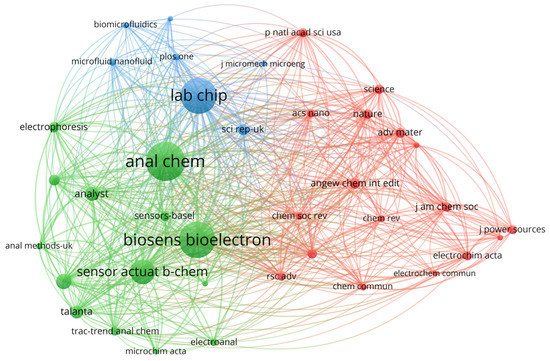
Figure 4.
The network map of journals sources of co-citation in this field.
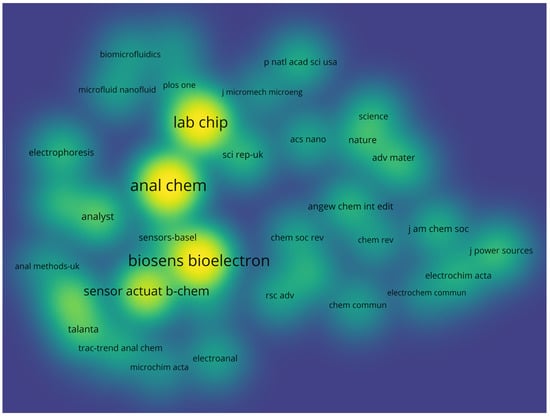
Figure 5.
The density visualization of journals sources of co-citation in this field.
3.5. Keywords Analysis and Network
Keywords indicate the author’s high concentration and summary of the whole article, which can largely reflect the research hotspots in the field. Keywords analysis is helpful to grasp the core topics of the article and help us understand the research trends.
A total of 2127 keywords in collected data are retrieved from 2012 to 2021. The keywords occurring more than 25 times were selected for network visualization analysis. As shown in Figure 6, each circle represents a keyword. The size of the circle reflects the frequency of keyword co-occurrence, and the larger the circle, the higher the frequency of keyword co-occurrence.
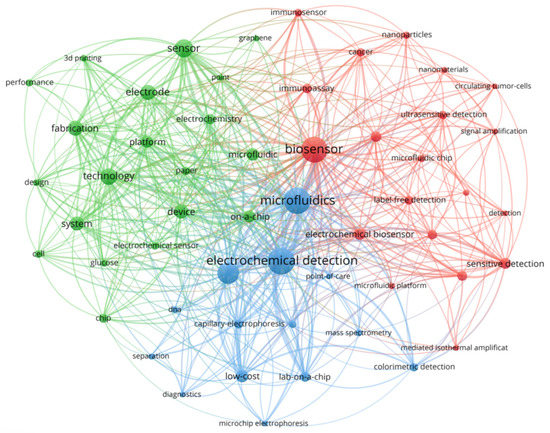
Figure 6.
The network map of co-occurrence keywords in this field.
The distance and thickness of the lines indicate the degree of correlation between them, and the same color circle means that they belong to a cluster. The co-occurrence keywords visualization is divided into three clusters by VOSviewer software. The green cluster represents the design and manufacture of equipment related to electrochemical microfluidics; red cluster indicates the application of electrochemical microfluidics in biological detection; and the blue cluster includes detection methods and means related to electrochemical microfluidic. The top 15 high-frequency keywords were extracted and arranged in descending order of word frequency, as shown in Table 3. Among them, the keyword microfluidic appeared the most 136 times, followed by electric detection with 102 times and biosensor with 96 times, which demonstrates the close attention currently paid to electrochemical detection and biosensors in microfluidics. It can be seen from the top 15 keywords that the hottest topics include microfluidic electrochemical detection, biosensors, fabrication of microfluidic devices, and the development of low-cost detection platforms on chips.

Table 3.
Top 15 keywords with the the highest frequency of co-occurrence.
CiteSpace comes with a keyword analysis clustering function, which facilitates the identification of key research areas in a particular science over time by clustering and grouping words with distinctive features in that field. It performs clustering analysis by using the LLR algorithm on top of keyword co-occurrence mapping, with keywords as the basis for clustering. The LLR algorithm is the logarithmic likelihood ratio and one of the commonly used algorithms for extracting clustering label words. As shown in Figure 7, six core clusters were generated, namely systems, label free, electrochemistry, performance, low cost, and biosensor. This indicates that the hot research issues in this area include the development of label-free immunosensors, biosensors, microfluidic device performance, and low cost of equipment, which is generally consistent with the clustering results of VOSviewer.
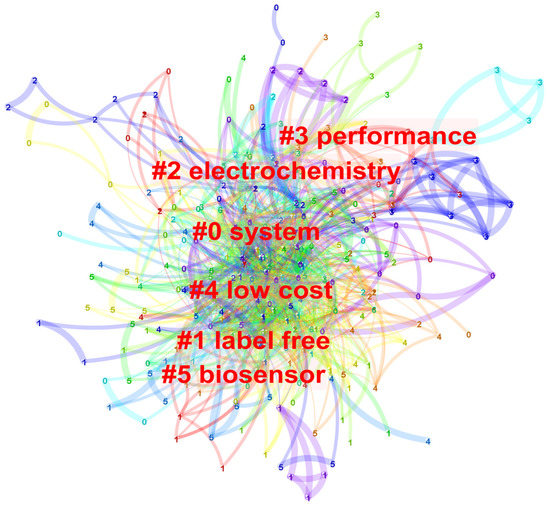
Figure 7.
Cluster analysis results for the keywords.
4. Applications of Electrochemical Microfluidic Technology
Electrochemical microfluidics has become an emerging technology with rapid development and application in several fields. In this paper, three applications in biomedicine, food safety, and environmental monitoring are collated and presented.
4.1. Biomedical
In recent years, there have been many studies on the application of electrochemical microfluidics in the medical field. It is undeniable that microfluidics has brought disruptive breakthroughs in disease treatment, drug screening, human toxicity testing and disease diagnosis. It will promote the development of modern science and technology at a high speed under the fourth industrial revolution with artificial intelligence as the core [23].
Although animals are often used for in vitro studies, animal model tests are usually not effective in simulating the mechanism of action of toxic cells in humans due to biological differences [24,25]. Instead, it is more ethical to use human organelles, cells, organs, or tissues as subjects for in vitro studies [26]. Among them, cells are the most widely used to construct in vitro models, drug sensitivity analysis, and biomedical research because of their simple structure, short duration, and low cost [27].
In some anticancer drug development and disease treatment processes, analyses involving activity, efficiency or toxicity often have requirements for drug concentration gradients. Traditional experimental platforms are difficult to achieve high-throughput screening due to the shortage of cost, reliability, and reaction time [28]. In contrast, microfluidic technology can achieve complex solution processing by setting up a network of microchannels, which can be used for pharmacological analysis. At the same time, the electrochemical analysis method can be more sensitive and faster for real-time detection.
Zhang et al. [29] proposed a 3D cultured liver chip based on microfluidic chip technology and it could be monitored in real time. The in vitro liver models are fabricated using PMMA chips and porous plates with integrated microporous arrays embedded in specific ducts. The chip is also continually injected with media and monitored in real time by measuring impedance and spectral values at different time points. Meanwhile, integrated sensors for the real-time monitoring of culture conditions and cell metabolism in cancer research are expected to further study complex in vitro models. Johannes Dornhof et al. [30] developed an organ platform on microfluidic chip based on heterogeneous 3D culture of matrix, which has a totally integrated electrochemical and biosensor array for energy metabolites oxygen, lactate, and glucose (as shown in Figure 8). The advanced microstructure allows the direct integration of cellular matrices with standard lab equipment, compartments, and microfluidic access. It enables quantitative and real-time access to responses to changes in culture conditions and cancer drug exposure. The utility and superiority of this platform were demonstrated with a single triple-negative breast cancer stem cell study subject from a patient.
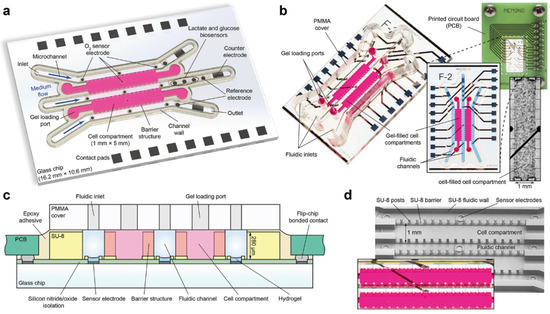
Figure 8.
System design, configuration and micromachining: (a) Top-view of the sensor chip; (b) Photograph of the assembly device filled with colored hydrogel and with PMMA cover; (c) Schematic of the sensor cross-section, including the materials and techniques used; (d) SEM micrograph of the patterned SU-8 structure that constitutes the fluidic structure. Reprinted with permission from ref. [30]. Copyright 2022 Royal Society of Chemistry.
Microfluidic analysis as the core of disease diagnosis technology can measure samples from different individuals in parallel. The diversification of samples and miniaturization of analytical instruments are gradually replacing the current clinical diagnostic equipment, and some achievements have been made in the diagnosis of some diseases.
Diabetes has become a commonly globalized metabolic disease, which is not taken seriously because of its small harm to human body at the beginning. However, if not detected and treated in time, long-term high blood sugar will cause damage to the body’s organs and lead to a series of complications [31]. Therefore, real-time monitoring of blood glucose levels is important for the prevention, diagnosis, and treatment of diabetes. Cao et al. [32] constructed a novel 3D paper-based microfluidic electrochemical biosensor for glucose determination by photolithography and screen-printing techniques. A kind of rGO-TEPA/PB nanocomposite was prepared as a modification of the paper working electrode. The prepared nanocomposites performed good electrocatalytic reduction activity for H2O2, an enzyme-catalyzed reaction product. Under optimal conditions, the sensor can achieve a wide linear range and low detection limit and has been used successfully to determine the amount of glucose in human blood and sweat. The results from experiments are in good agreement with the values measured by blood glucose meter. In addition to sensors that rely on H2O2 catalysis for the indirect detection of glucose were investigated, Koklu et al. [33] have developed a sensor that can detect glucose directly without the help of an external medium (as shown in Figure 9). This was the first to integrate an n-type organic electrochemical transistor (OECT) with a microfluidic channel for real-time glucose testing. The electrical signal stability characteristics conferred by microfluidics are exploited, while transistor circuits are used to enhance the signal-to-noise ratio (SNR) and minimize the detection limit to the nM-range.

Figure 9.
(a) The chemical structure of the n-type conjugated polymer P-90; (b) the schematic of the OECT with the electrical connections; (c) a microscope image of the gate along with two channels; (d) Schematic of the perfusion system and microfluidic integrated OECT. Reprinted with permission from ref. [33]. Copyright 2021 Elsevier.
With the increasing demands on disease detectors, it becomes necessary to evaluate them against the background conditions of other factors. Bruch et al. [34] presented a multiplexable electrochemical microfluidic biosensor that divides a single channel into multiple subparts. Four new chip designs were created that can be used to analyze up to eight different miRNAs. The greatest advantage offered by the sensor in terms of multiplexing capability is the flexibility to target those RNAs of interest from a single clinical sample using only one effector protein without the need to change the sensor or measurement device.
Recently, wearable sensors have attracted extensive research in health management [35] and sports monitoring [36] due to their small size, portability, functional integration, and other advantages. Paz et al. [37] described a wearable electrochemical device for glucose monitoring. The proposed device allows for long-term non-invasive monitoring of changes in human blood glucose levels. Lactate sensors for sweat analysis also gain attention in sports and medical fields. Xing et al. [38] developed a wearable device to monitor sweat lactate on the human body, and the biosensor also maintains a response to changes in pH and temperature.
4.2. Food Analysis
With the increasing variety of foods and demand for food, the use of some chemicals in agriculture and industry has risen rapidly. Hundreds of foodborne disease outbreaks and food recalls were reported worldwide every year [39], especially in some developing countries. This has led to a growing concern with regard to food safety issues, along with the need to develop food safety testing technologies.
Food safety is the proper protection of food from contamination during the stages of preparation, handling, storage and disposal [40]. High performance liquid chromatography, gas chromatography and other traditional analytical methods have been used to detect pollutants and toxicity in agricultural products and food [41]. Although these techniques have achieved some results, they have high initial costs and are very unportable. Compared with some traditional analytical methods, microfluidics combined with electrochemical technology has the advantages of being more portable, low-cost, and sensitive. It has been well used in food detection, e.g., in detecting microorganisms, pesticides, and heavy metals contained in food products.
Silva et al. [42] designed a paper-based label-free potential immunosensor based on the surface barrier principle for the detection of Salmonella typhimurium. The paper-based ion selective electrode was incorporated with a filter paper pad that can hold the internally filled solution, and the design provided a platform for antibody immobilization. It was also a simple and economical way to control the ion flux through the polymer membrane. Optimized conditions achieved a detection limit of 5 cells mL−1 in phosphate buffer. The sensor was applied to the quantitative analysis of Salmonella in apple juice and showed a good performance.
In recent years, compared to conventional microfluidic chips and paper-based microfluidic chips that have emerged, the manufacturing of threaded microfluidic chips has become simpler and less demanding, offering low cost, Simple operation, high availability, and ease of portability [43,44]. Jiang et al. [45] used label-free aptamer immunosensing technology to design a thread-based microfluidic electrochemical aptamer sensor for the speedy and sensitive detection of Vibrio parahaemolyticus in marine products (as shown in Figure 10). The designed sensor eliminated the limitations of many conventional microfluidic devices using external pumps, and molybdenum disulfide (MoS2) fixed on the electrode surface can enhance electrochemical sensitivity. The proposed sensor has a detection limit of 5.74 CFU mL−1, with higher detection sensitivity and shorter detection time (30 min).
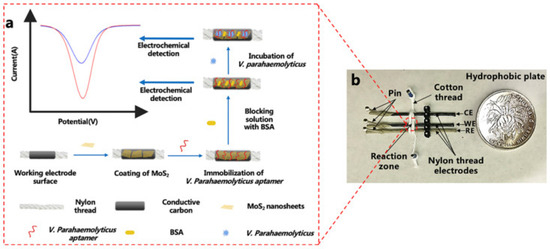
Figure 10.
(a) Schematic representation of detection mechanism of the sensors; (b) Prototype of the final thread-based microfluidic aptasensor. Reprinted with permission from ref. [45]. Copyright 2021 Elsevier.
In addition to detecting biological contaminants in spoiled food, it can also detect some heavy metal ions from the food chain, such as lead and arsenic ions in water. These heavy metal ions are very harmful to humans and may lead to multi-organ failure in humans [46]. Gupta et al. [47] combined microfluidics with α-MnO2/GQD nanocomposites to develop a small portable resistive device for the detection of lead ions, which exhibits great potential for integration with conventional water purification devices to indicate the safety index of drinking water (as shown in Figure 11). The Au microelectrodes modified by α-MnO2/GQD nanocomposites showed good complexation and high electron transfer kinetic ability for Pb(II). The proposed portable sensor was evaluated at low sample volumes (200 µL) and in the concentration range from 0.001 nM to 1 uM, while being available for approximately 45 days.

Figure 11.
Schematic of nanosensor fabrication and the Pb(II) detection strategy using portable resistive device and validation with the impedance analyzer (EIS). Reprinted with permission from ref. [47]. Copyright 2021 The Institution of Engineering and Technology.
4.3. Environmental Monitoring
With the increasing industrial wastewater, agricultural products, and residual waste from human activities, it is most obvious that the water quality of surface and drinking water has become deteriorated [48]. The pollutants that cause water quality deterioration are pesticides, bacteria, heavy metals, and some new pollutants. Once these pollutants enter the human body, they will bring a series of serious diseases to the human body [49]. Microfluidic technology combined with electrochemical technology has been applied in the field of environmental monitoring.
The spread of waterborne diseases associated with bacteria is one of the major problems affecting human health. Some common bacteria in water are Escherichia coli, Salmonella, and Shigella [48]. Altintas et al. [50] designed a fully automated microfluidic electrochemical biosensor for the specific detection of Escherichia coli. The quantitative detection of Escherichia coli in water samples was performed using a nanomaterial amplification immunoassay with a detection limit of 50 cfu mL−1. In addition, the sensor surface can be regenerated multiple times, further reducing the cost of detection. It is proven for the first time that the designed biosensor device can monitor and detect bacterial pathogens with the developed detection protocol.
Over the years, some heavy metal contaminants have been widely present in water and soil, accumulating through the food chain and entering the human body. Mercury ions can cause respiratory failure and neurological disorders in humans. Nguyen et al. [51] designed an electrochemical sensor based on PDMS to detect mercury ions by forming a conductive (Pani-SDS) film with good selectivity. Lead ions can damage the brain, causing memory loss, and may also cause anemia and osteoporosis. Lead ions will not only damage the brain and cause memory loss, but also cause anemia and osteoporosis in the human body. Silva et al. [52] designed a potential sensor based on metal modified paper to detect lead ions in complex environmental samples. Using different metal-thin modified paper substrates in combination with lead ion selective electrodes, it was found that the paper substrate coated with a 38-nm gold layer resulted in the best performance of the ISE, while the service life of the modified sensor was extended.
Pesticides were used worldwide to improve vegetable, fruit, and food production. Although the use of some persistent and toxic pesticides has been banned, those less persistent pesticides can also cause serious harm to humans [53]. Therefore, the detection of low concentrations of pesticides in water was necessary to protect the environment and human health. Arduini et al. [54] presented an integrated electrochemical biosensor based on three-dimensional origami for the first time. The sensor detects multiple pesticides by loading different enzymes and enzyme substrates using an integrated device consisting of office paper, screen-printed electrodes, and multiple filter paper pads. Enzyme activity in the absence and presence of pesticides was monitored using a portable constant potential meter to assess the degree of inhibition associated with the amount of pesticide. The electrodes were modified accordingly to improve their sensitivity. The proposed device would not require sample processing, and satisfactory results have been obtained by collecting and analyzing actual river water samples (as shown in Figure 12).
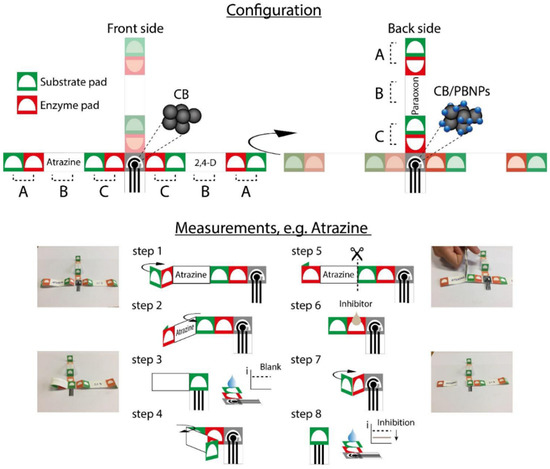
Figure 12.
Schematic representation and photographs of the configuration of the paper-based platform and measurement procedure. Reprinted with permission from ref. [54]. Copyright 2019 Elsevier.
An increasing number of novel pollutants in the environment have attracted widespread attention. Jemmeli et al. [55] designed a paper-based electrochemical sensor for rapid detection of BPA in rivers and drinking water. Carbon black nanomaterials were used as working electrodes combined with filter paper and quantified using square wave voltammetry. The effectiveness of the carbon black and paper-based sensor for drinking water analysis and environmental monitoring was demonstrated for the first time (as shown in Figure 13).
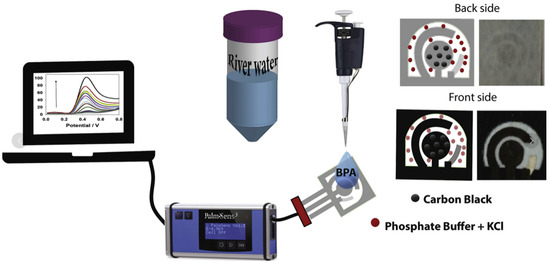
Figure 13.
Schematic representation of the configuration of paper-based sensor and measurement procedure. Reprinted with permission from ref. [55]. Copyright 2020 Elsevier.
5. Conclusions and Future Perspective
In this paper, the overall research trends in the field of electrochemical microfluidics from 2012–2021 were clarified by searching and analyzing the core databases on the Web of Science. Statistical analysis using bibliometric methods shows that the number of publications on electrochemical microfluidics research is increasing year by year, and the collaboration among authors in this field is relatively weak. China and the United States are the two countries with the highest number of publications in the statistical time frame. Biosensors & bioelectronics is ahead of other academic journals and has the highest number of publications on this topic. The analysis of keywords reveals that the research hotspots include microfluidic electrochemical detection, biosensors, fabrication of microfluidic devices, and the design of low-cost microchip detection platforms.
Based on the results of the analysis, possible research directions in the coming years should focus on the following areas:
- Polymer materials remain the mainstream materials for microfluidic equipment substrate, but they have limitations in practical applications. Sometimes it is necessary to improve the surface modification and immobilization methods according to the requirements, which may affect their performance. Therefore, further research and exploration of new friendly and stable materials are required. Compared with traditional microfluidic chips based on glass and polymer, paper chips have the advantages of low cost, simple fabrication process, strong capillarity, and good biocompatibility. Progress has been made in some fields [56], and more attention can continue to be given to paper-based microfluidics in the future.
- For the electrode of electrochemical detection, the first step is to find suitable electrode with good stability, low price and high catalytic activity. At the same time, in order to further improve its detection sensitivity, the development of new composite electrode and particle electrode is also an important research direction. Laser-scribed graphene (LSG) electrodes are widely used in some miniaturized and lab-on-a-chip systems, and this miniaturized LSG electrode is also very interesting [57].
- Currently, most of the microfluidic analysis is developed for single target, however, high throughput analysis of multiple components is one of the most desirable features for electrochemical microfluidic analysis. The realization of multi-dimensional detection as well as real-time monitoring of multiple components calls for a highly sensitive and selective microfluidic detection system, meriting further research. A paper-based analytical device (PAD) coupled with a colorimetric method has been reported for the rapid and highly sensitive determination of four chemical food additives in food [58].
- Large scale integration is a significant advantage of microfluidic chips and there are still many deficiencies and challenges to overcome. How to integrate each operation unit into a multi-functional microfluidic platform on a large scale and realize automatic intelligent operation still needs further efforts and research. A paper-based hygrothermal mechanical microactuator triggered by microliter droplets of aqueous solution has been proposed, and the autonomously controlled microactuator is suitable for microfluidic applications [59]. At the same time, attention should also be paid to reducing complexity, making the system more stable and low-cost. A novel composite material of cellulose fibers with embedded zinc micoparticles has been developed to be used in microfluidic devices to reduce the complexity of the devices [60].
- Photolithography, injection molding, laser cutting, or the use of ink jet or wax printing are techniques that have been used to create microfluidic devices. With the rise of 3D printing technology and the requirement for more complex microfluidic chip configurations, 3D printing technology has shown potential for microfluidic systems and microelectronic devices. However, no single 3D printing method currently shows ideal characteristics for building microfluidic devices with fully integrated microelectronics. Accelerating the development of next-generation 3D printed microfluidic systems as well as developing new technologies for building microfluidic devices to achieve fully autonomous microelectronic integration is a future direction to work on. At the same time, future trends will focus on research to develop portable devices to perform point-of-care analysis of results in the field.
Author Contributions
Conceptualization, X.Z., Y.Z. and X.L.; methodology, X.Z. and Y.Z.; software, Y.Z.; investigation, X.Z. and W.G.; resources, X.Z. and W.G.; data curation, X.Z.; writing—original draft preparation, X.Z.; writing—review and editing, X.Z., W.G., S.J. and X.L.; visualization, Y.Z.; supervision, X.L.; project administration, W.G. and X.L.; funding acquisition, X.L. All authors have read and agreed to the published version of the manuscript.
Funding
This research was partially funded by the Natural Science Foundation of Tianjin City, Grant No. 21YFSNSN00180 and the National Key R&D Program of China, Grant No. 2019YFC1407800.
Institutional Review Board Statement
Not applicable.
Informed Consent Statement
Not applicable.
Data Availability Statement
The data used to support the findings of this study are available from the corresponding author upon reasonable request.
Acknowledgments
Authors thank their universities for scientific database subscriptions and CECEP Talroad Technology Co., Ltd. for project support that enabled this collaborative research.
Conflicts of Interest
The authors declare no conflict of interest.
References
- Bougas, L.; Langenegger, L.D.; Mora, C.A.; Zeltner, M.; Stark, W.J.; Wickenbrock, A.; Blanchard, J.W.; Budker, D. Nondestructive in-line sub-picomolar detection of magnetic nanoparticles in flowing complex fluids. Sci. Rep. 2018, 8, 3491. [Google Scholar] [CrossRef] [PubMed]
- Squires, T.M.; Quake, S.R. Microfluidics: Fluid physics at the nanoliter scale. Rev. Mod. Phys. 2005, 77, 977–1026. [Google Scholar] [CrossRef]
- Boken, J.; Soni, S.K.; Kumar, D. Microfluidic synthesis of nanoparticles and their biosensing applications. Crit. Rev. Anal. Chem. 2016, 46, 538–561. [Google Scholar] [CrossRef] [PubMed]
- Chen, Z.; Shen, L.; Zhao, X.; Chen, H.; Xiao, Y.; Zhang, Y.; Yang, X.; Zhang, J.; Wei, J.; Hao, N. Acoustofluidic micromixers: From rational design to lab-on-a-chip applications. Appl. Mater. Today 2022, 26, 101356. [Google Scholar] [CrossRef]
- Noh, J.; Kim, H.C.; Chung, T.D. Biosensors in microfluidic chips. Top. Curr. Chem. 2011, 304, 117–152. [Google Scholar] [CrossRef]
- Illath, K.; Kar, S.; Gupta, P.; Shinde, A.; Wankhar, S.; Tseng, F.-G.; Lim, K.-T.; Nagai, M.; Santra, T.S. Microfluidic nanomaterials: From synthesis to biomedical applications. Biomaterials 2022, 280, 121247. [Google Scholar] [CrossRef]
- Ma, W.; Liu, L.; Xu, Y.; Wang, L.; Chen, L.; Yan, S.; Shui, L.; Wang, Z.; Li, S. A highly efficient preconcentration route for rapid and sensitive detection of endotoxin based on an electrochemical biosensor. Analyst 2020, 145, 4204–4211. [Google Scholar] [CrossRef]
- Kutluk, H.; Bruch, R.; Urban, G.A.; Dincer, C. Impact of assay format on miRNA sensing: Electrochemical microfluidic biosensor for miRNA-197 detection. Biosens. Bioelectron. 2020, 148, 111824. [Google Scholar] [CrossRef]
- Hu, X.; Dong, Y.; He, Q.; Chen, H.; Zhu, Z. Fabrication of a polystyrene microfluidic chip coupled to electrospray ionization mass spectrometry for protein analysis. J. Chromatogr. B 2015, 990, 96–103. [Google Scholar] [CrossRef]
- Meng, J.; You, J.B.; Arends, G.F.; Hao, H.; Tan, X.; Zhang, X. Microfluidic device coupled with total internal reflection microscopy for in situ observation of precipitation. Eur. Phys. J. E 2021, 44, 57. [Google Scholar] [CrossRef]
- Charbaji, A.; Heidari-Bafroui, H.; Rahmani, N.; Anagnostopoulos, C.; Faghri, M. A 3D Printed Lightbox for Enhancing Nitrate Detection in the Field Using Microfluidic Paper-Based Devices. Present. Innov. Microfluid. 2022, 3, 1–27. [Google Scholar]
- Navratil, T. Application and Utilization of Electrochemistry in Organic Chemistry. Curr. Org. Chem. 2011, 15, 2921–2922. [Google Scholar] [CrossRef]
- Whitesides, G.M. The origins and the future of microfluidics. Nature 2006, 442, 368–373. [Google Scholar] [CrossRef] [PubMed]
- Hamzah, H.H.; Shafiee, S.A.; Abdalla, A.; Patel, B.A. 3D printable conductive materials for the fabrication of electrochemical sensors: A mini review. Electrochem. Commun. 2018, 96, 27–31. [Google Scholar] [CrossRef]
- Pursey, J.P.; Chen, Y.; Stulz, E.; Park, M.K.; Kongsuphol, P. Microfluidic electrochemical multiplex detection of bladder cancer DNA markers. Sens. Actuators B Chem. 2017, 251, 34–39. [Google Scholar] [CrossRef]
- Hong, S.A.; Kim, Y.J.; Kim, S.J.; Yang, S. Electrochemical detection of methylated DNA on a microfluidic chip with nanoelectrokinetic pre-concentration. Biosens. Bioelectron. 2018, 107, 103–110. [Google Scholar] [CrossRef]
- Irfan, M.; Liu, X.; Hussain, K.; Mushtaq, S.; Cabrera, J.; Zhang, P. The global research trend on cadmium in freshwater: A bibliometric review. Environ. Sci. Pollut. Res. 2021, 1–14. [Google Scholar] [CrossRef]
- Dai, Y.; Liu, M.; Li, J.; Kang, N.; Ahmed, A.; Zong, Y.; Tu, J.; Chen, Y.; Zhang, P.; Liu, X. Graphene-Based Membranes for Water Desalination: A Literature Review and Content Analysis. Polymers 2022, 14, 4246. [Google Scholar] [CrossRef]
- Colares, G.S.; Dell’Osbel, N.; Wiesel, P.G.; Oliveira, G.A.; Lemos, P.H.Z.; da Silva, F.P.; Lutterbeck, C.A.; Kist, L.T.; Machado, Ê.L. Floating treatment wetlands: A review and bibliometric analysis. Sci. Total Environ. 2020, 714, 136776. [Google Scholar] [CrossRef]
- Jiao, S.; Li, Y.; Li, J.; Abrha, H.; Liu, M.; Cui, J.; Wang, J.; Dai, Y.; Liu, X. Graphene oxide as a versatile platform for emerging hydrovoltaic technology. J. Mater. Chem. A 2022, 10, 18451–18469. [Google Scholar] [CrossRef]
- Zhang, C.; Xu, T.; Feng, H.; Chen, S. Greenhouse gas emissions from landfills: A review and bibliometric analysis. Sustainability 2019, 11, 2282. [Google Scholar] [CrossRef]
- Li, J.; Mao, Y.; Ouyang, J.; Zheng, S. A Review of Urban Microclimate Research Based on CiteSpace and VOSviewer Analysis. Int. J. Environ. Res. Public Health 2022, 19, 4741. [Google Scholar] [CrossRef]
- Maurya, R.; Gohil, N.; Bhattacharjee, G.; Khambhati, K.; Alzahrani, K.J.; Ramakrishna, S.; Chu, D.-T.; Singh, V. Advances in microfluidics devices and its applications in personalized medicines. Prog. Mol. Biol. Transl. Sci. 2022, 186, 191–201. [Google Scholar] [CrossRef]
- Swinney, D.C.; Anthony, J. How were new medicines discovered? Nat. Rev. Drug. Disc. 2011, 10, 507–519. [Google Scholar] [CrossRef]
- Herland, A.; Maoz, B.M.; Das, D.; Somayaji, M.R.; Prantil-Baun, R.; Novak, R.; Cronce, M.; Huffstater, T.; Jeanty, S.S.F.; Ingram, M.; et al. Quantitative prediction of human pharmacokinetic responses to drugs via fluidically coupled vascularized organ chips. Nat. Biomed. Eng. 2020, 4, 421–436. [Google Scholar] [CrossRef]
- Leist, M.; Hasiwa, N.; Rovida, C.; Daneshian, M.; Basketter, D.; Kimber, I.; Clewell, H.; Gocht, T.; Goldberg, A.; Busquet, F.; et al. Consensus report on the future of animal-free systemic toxicity testing. ALTEX 2014, 31, 341–356. [Google Scholar] [CrossRef]
- Mulholland, T.; McAllister, M.; Patek, S.; Flint, D.; Underwood, M.; Sim, A.; Edwards, J.; Zagnoni, M. Drug screening of biopsy-derived spheroids using a self-generated microfluidic concentration gradient. Sci. Rep. 2018, 8, 14672. [Google Scholar] [CrossRef]
- Sugiura, S.; Hattori, K.; Kanamori, K. Microfluidic Serial Dilution Cell-Based Assay for Analyzing Drug Dose Response over a Wide Concentration Range. Anal. Chem. 2010, 82, 8278–8282. [Google Scholar] [CrossRef]
- Zhang, Y.; Yang, N.; Xie, L.; Shu, F.; Shi, Q.; Shaheen, N. A New 3D Cultured Liver Chip and Real-Time Monitoring System Based on Microfluidic Technology. Micromachines 2020, 11, 1118. [Google Scholar] [CrossRef]
- Dornhof, J.; Kieninger, J.; Muralidharan, H.; Maurer, J.; Urban, G.A.; Weltin, A. Microfluidic organ-on-chip system for multi-analyte monitoring of metabolites in 3D cell cultures. Lab Chip 2022, 22, 225–239. [Google Scholar] [CrossRef]
- Chen, Y.; Li, P.; Modica, J.A.; Drout, R.J.; Farha, O.K. Acid-Resistant Mesoporous Metal-Organic Framework toward Oral Insulin Delivery: Protein Encapsulation, Protection, and Release. J. Am. Chem. Soc. 2018, 140, 5678–5681. [Google Scholar] [CrossRef]
- Cao, L.; Han, G.C.; Xiao, H.; Chen, Z.; Fang, C. A novel 3D paper-based microfluidic electrochemical glucose biosensor based on rGO-TEPA/PB sensitive film. Anal. Chim. Acta 2020, 1096, 34–43. [Google Scholar] [CrossRef]
- Koklu, A.; Ohayon, D.; Wustoni, S.; Hama, A.; Chen, X.; McCulloch, I.; Inal, S. Microfluidics integrated n-type organic electrochemical transistor for metabolite sensing. Sens. Actuators B Chem. 2021, 329, 129251. [Google Scholar] [CrossRef]
- Bruch, R.; Johnston, M.; Kling, A.; Mattmüller, T.; Baaske, J.; Partel, S.; Madlener, S.; Weber, W.; Urban, G.A.; Dincer, C. CRISPR-powered electrochemical microfluidic multiplexed biosensor for target amplification-free miRNA diagnostics. Biosens. Bioelectron. 2021, 177, 112887. [Google Scholar] [CrossRef]
- Bariya, M.; Nyein, H.Y.Y.; Javey, A. Wearable sweat sensors. Nat. Electron. 2018, 1, 160–171. [Google Scholar] [CrossRef]
- Zheng, Q.; Lee, J.H.; Shen, X.; Chen, X.; Kim, J.-K. Graphene-based wearable piezoresistive physical sensors. Mater. Today 2020, 36, 158–179. [Google Scholar] [CrossRef]
- De la Paz, E.; Barfidokht, A.; Rios, S.; Brown, C.; Chao, E.; Wang, J. Extended Noninvasive Glucose Monitoring in the Interstitial Fluid Using an Epidermal Biosensing Patch. Anal. Chem. 2021, 93, 12767–12775. [Google Scholar] [CrossRef]
- Xing, X.; Pérez-Ràfols, C.; Chen, C.; Cuartero, M.; Crespo, G.A. Lactate Biosensing for Reliable On-Body Sweat Analysis. ACS Sens. 2021, 6, 2763–2771. [Google Scholar] [CrossRef]
- Paramithiotis, S.; Drosinos, E.H.; Skandamis, P.N. Food recalls and warnings due to the presence of foodborne pathogens—A focus on fresh fruits, vegetables, dairy and eggs. Curr. Opin. Food Sci. 2017, 18, 71–75. [Google Scholar] [CrossRef]
- Zhang, Y.; Li, G.; Wu, D.; Li, X.; Yu, Y.; Luo, P.; Chen, J.; Dai, C.; Wu, Y. Recent advances in emerging nanomaterials based food sample pretreatment methods for food safety screening. Trends Anal. Chem. 2019, 121, 115669. [Google Scholar] [CrossRef]
- Guo, L.; Feng, J.; Fang, Z.; Xu, J.; Lu, X. Application of microfluidic “lab-on-a-chip” for the detection of mycotoxins in foods. Trends Food Sci. Technol. 2015, 46, 252–263. [Google Scholar] [CrossRef]
- Silva, N.F.D.; Almeida, C.M.R.; Magalhães, J.M.C.S.; Gonçalves, M.P.; Freire, C.; Delerue-Matos, C. Development of a disposable paper-based potentiometric immunosensor for real-time detection of a foodborne pathogen. Biosens. Bioelectron. 2019, 141, 111317. [Google Scholar] [CrossRef]
- Agustini, D.; Fedalto, L.; Bergamini, M.F.; Marcolino-Junior, L.H. Microfluidic thread based electroanalytical system for green chromatographic separations. Lab Chip 2018, 18, 670–678. [Google Scholar] [CrossRef]
- Kabariya, R.B.; Ramani, V.M. Study of thread properties for their possible use in fabrication of diagnostic microfluidic device. Man-Made Text. India 2018, 46, 226–230. [Google Scholar]
- Jiang, H.; Sun, Z.; Guo, Q.; Weng, X. Microfluidic thread-based electrochemical aptasensor for rapid detection of Vibrio parahaemolyticus. Biosens. Bioelectron. 2021, 182, 113191. [Google Scholar] [CrossRef]
- Xu, G.; Song, P.; Xia, L. Examples in the detection of heavy metal ions based on surface-enhanced Raman scattering spectroscopy. Nanophotonics 2021, 10, 4419–4445. [Google Scholar] [CrossRef]
- Gupta, A.K.; Khanna, M.; Roy, S.; Pankaj; Nagabooshanam, S.; Kumar, R.; Wadhwa, S.; Mathur, A. Design and development of a portable resistive sensor based on α-MnO2/GQD nanocomposites for trace quantification of Pb (II) in water. IET Nanobiotechnol. 2021, 15, 505–511. [Google Scholar] [CrossRef]
- Shaik, S.; Saminathan, A.; Sharma, D.; Krishnaswamy, J.A.; Mahapatra, D.R. Monitoring microbial growth on a microfluidic lab-on-chip with electrochemical impedance spectroscopic technique. Biomed. Microdevices 2021, 23, 26. [Google Scholar] [CrossRef]
- Amoatey, P.; Baawain, M.S. Effects of pollution on freshwater aquatic organisms. Water Environ. Res. 2019, 91, 1272–1287. [Google Scholar] [CrossRef]
- Altintas, Z.; Akgun, M.; Kokturk, G.; Uludag, Y. A fully automated microfluidic-based electrochemical sensor for real-time bacteria detection. Biosens. Bioelectron. 2018, 100, 541–548. [Google Scholar] [CrossRef]
- Nguyen, H.L.; Cao, H.H.; Nguyen, D.T.; Nguyen, V.A. Sodium Dodecyl Sulfate Doped Polyaniline for Enhancing the Electrochemical Sensitivity of Mercury Ions. Electroanal. 2017, 29, 595–601. [Google Scholar] [CrossRef]
- Silva, R.; Ahamed, A.; Cheong, Y.H.; Zhao, K.; Ding, R.; Lisak, G. Non-equilibrium potentiometric sensors integrated with metal modified paper-based microfluidic solution sampling substrates for determination of heavy metals in complex environmental samples. Anal. Chim. Acta 2022, 1197, 339495. [Google Scholar] [CrossRef]
- Richardson, J.R.; Fitsanakis, V.; Westerink, R.H.S.; Kanthasamy, A.G. Neurotoxicity of pesticides. Acta Neuropathol. 2019, 138, 343–362. [Google Scholar] [CrossRef]
- Arduini, F.; Cinti, S.; Caratelli, V.; Amendola, L.; Palleschi, G.; Moscone, D. Origami multiple paper-based electrochemical biosensors for pesticide detection. Biosens. Bioelectron. 2019, 126, 346–354. [Google Scholar] [CrossRef]
- Jemmeli, D.; Marcoccio, E.; Moscone, D.; Dridi, C.; Arduini, F. Highly sensitive paper-based electrochemical sensor for reagent free detection of bisphenol A. Talanta 2020, 216, 120924. [Google Scholar] [CrossRef]
- Wang, J.; Yang, L.; Wang, H.; Wang, L. Application of Microfluidic Chips in the Detection of Airborne Microorganisms. Micromachines 2022, 13, 1576. [Google Scholar] [CrossRef]
- Rao, L.T.; Dubey, S.K.; Javed, A.; Goel, S. Paper-based optimized chemical fuel cell with laser-scribed graphene electrodes for energy harvesting. Microfluid. Nanofluidics 2021, 25, 1–13. [Google Scholar] [CrossRef]
- Ratnarathorn, N.; Dungchai, W. Paper-based Analytical Device (PAD) for the Determination of Borax, Salicylic Acid, Nitrite, and Nitrate by Colorimetric Methods. J. Anal. Chem. 2020, 75, 487–494. [Google Scholar] [CrossRef]
- Ireta-Muñoz, L.A.; Cueva-Perez, I.; Saucedo-Dorantes, J.J.; Pérez-Cruz, A. A Paper-Based Cantilever Beam Mini Actuator Using Hygro-Thermal Response. Actuators 2022, 11, 94. [Google Scholar] [CrossRef]
- Charbaji, A.; Smith, W.; Anagnostopoulos, C.; Faghri, M. Zinculose: A new fibrous material with embedded zinc particles. Eng. Sci. Technol. Int. J. 2021, 24, 571–578. [Google Scholar] [CrossRef]
Disclaimer/Publisher’s Note: The statements, opinions and data contained in all publications are solely those of the individual author(s) and contributor(s) and not of MDPI and/or the editor(s). MDPI and/or the editor(s) disclaim responsibility for any injury to people or property resulting from any ideas, methods, instructions or products referred to in the content. |
© 2022 by the authors. Licensee MDPI, Basel, Switzerland. This article is an open access article distributed under the terms and conditions of the Creative Commons Attribution (CC BY) license (https://creativecommons.org/licenses/by/4.0/).